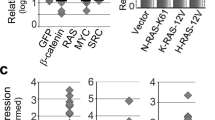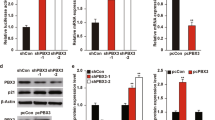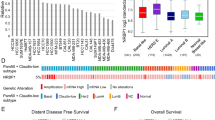Abstract
The contribution of the insulin-like growth-factor-I receptor (IGF-IR) to tumour progression is well documented. To identify new mediators of IGF-IR function in cancer, we recently isolated genes differentially expressed in cells overexpressing the IGF-IR. Among these was the serine/threonine kinase PBK/TOPK (PDZ-binding kinase/T-LAK cell-originated protein kinase), previously associated with highly proliferative cells and tissues. Here, we show that PBK is expressed at high levels in tumour cell lines compared with non-transformed cells. IGF-I could induce PBK expression only in transformed cells, whereas epidermal growth factor could induce PBK in non-transformed MCF-10A breast epithelial cells. Suppression of PBK expression using small interfering RNA did not prevent progression through the cell cycle, but caused decreased proliferation over time in culture, and reduced clonogenic growth in soft agarose. PBK knockdown impaired p38 activation after long-term stimulation with different growth factors and reduced DU145 cells motility. Suppressed PBK expression also resulted in an impaired response to DNA damage that was evident by the decreased generation of γ-H2AX, increased DNA damage and decreased cell survival. Taken together, the data indicate that PBK is necessary for appropriate activation and function of the p38 pathway by growth factors. Thus, enhanced expression of PBK may facilitate tumour growth by mediating p38 activation and by helping cells to overcome DNA damage.
This is a preview of subscription content, access via your institution
Access options
Subscribe to this journal
Receive 50 print issues and online access
$259.00 per year
only $5.18 per issue
Buy this article
- Purchase on Springer Link
- Instant access to full article PDF
Prices may be subject to local taxes which are calculated during checkout





Similar content being viewed by others
References
Abe Y, Matsumoto S, Kito K, Ueda N . (2000). Cloning and expression of a novel MAPKK-like protein kinase, lymphokine-activated killer T-cell-originated protein kinase, specifically expressed in the testis and activated lymphoid cells. J Biol Chem 275: 21525–21531.
Bartucci M, Morelli C, Mauro L, Ando S, Surmacz E . (2001). Differential insulin-like growth factor I receptor signaling and function in estrogen receptor (ER)-positive MCF-7 and ER-negative MDA-MB-231 breast cancer cells. Cancer Res 61: 6747–6754.
Cleaver JE . (2005). Cancer in xeroderma pigmentosum and related disorders of DNA repair. Nat Rev Cancer 5: 564–573.
Cote S, Simard C, Lemieux R . (2002). Regulation of growth-related genes by interleukin-6 in murine myeloma cells. Cytokine 20: 113–120.
Dendouga N, Gao H, Moechars D, Janicot M, Vialard J, McGowan CH . (2005). Disruption of murine Mus81 increases genomic instability and DNA damage sensitivity but does not promote tumorigenesis. Mol Cell Biol 25: 7569–7579.
Dougherty JD, Garcia AD, Nakano I, Livingstone M, Norris B, Polakiewicz R et al. (2005). PBK/TOPK, a proliferating neural progenitor-specific mitogen-activated protein kinase kinase. J Neurosci 25: 10773–10785.
Dupont J, Dunn SE, Barrett JC, LeRoith D . (2003). Microarray analysis and identification of novel molecules involved in insulin-like growth factor-1 receptor signaling and gene expression. Recent Prog Horm Res 58: 325–342.
Fernandez-Capetillo O, Lee A, Nussenzweig M, Nussenzweig A . (2004). H2AX: the histone guardian of the genome. DNA Repair (Amsterdam) 3: 959–967.
Friedmann B, Caplin M, Hartley JA, Hochhauser D . (2004). Modulation of DNA repair in vitro after treatment with chemotherapeutic agents by the epidermal growth factor receptor inhibitor gefitinib (ZD1839). Clin Cancer Res 10: 6476–6486.
Fujibuchi T, Abe Y, Takeuchi T, Ueda N, Shigemoto K, Yamamoto H et al. (2005). Expression and phosphorylation of TOPK during spermatogenesis. Dev Growth Differ 47: 637–644.
Gaudet S, Branton D, Lue RA . (2000). Characterization of PDZ-binding kinase, a mitotic kinase. Proc Natl Acad Sci USA 97: 5167–5172.
Heron-Milhavet L, Karas M, Goldsmith CM, Baum BJ, LeRoith D . (2001). Insulin-like growth factor-I (IGF-I) receptor activation rescues UV-damaged cells through a p38 signaling pathway. Potential role of the IGF-I receptor in DNA repair. J Biol Chem 276: 18185–18192.
Heron-Milhavet L, LeRoith D . (2002). Insulin-like growth factor I induces MDM2-dependent degradation of p53 via the p38 MAPK pathway in response to DNA damage. J Biol Chem 277: 15600–15606.
Hofmann F, Garcia-Echeverria C . (2005). Blocking the insulin-like growth factor-I receptor as a strategy for targeting cancer. Drug Discov Today 10: 1041–1047.
Huang C, Jacobson K, Schaller MD . (2004). MAP kinases and cell migration. J Cell Sci 117: 4619–4628.
Kiely PA, Leahy M, O'Gorman D, O'Connor R . (2005). RACK1-mediated integration of adhesion and insulin-like growth factor I (IGF-I) signaling and cell migration are defective in cells expressing an IGF-I receptor mutated at tyrosines 1250 and 1251. J Biol Chem 280: 7624–7633.
Kim MS, Lee EJ, Kim HR, Moon A . (2003). p38 kinase is a key signaling molecule for H-Ras-induced cell motility and invasive phenotype in human breast epithelial cells. Cancer Res 63: 5454–5461.
Lee-Kwon W, Park D, Bernier M . (1998). Nucleotide excision repair is not required for the antiapoptotic function of insulin-like growth factor 1. Exp Cell Res 241: 458–466.
Lisby M, Rothstein R . (2004). DNA damage checkpoint and repair centers. Curr Opin Cell Biol 16: 328–334.
Loughran G, Healy NC, Kiely PA, Huigsloot M, Kedersha NL, O'Connor R . (2005a). Mystique is a new insulin-like growth factor-I-regulated PDZ-LIM domain protein that promotes cell attachment and migration and suppresses Anchorage-independent growth. Mol Biol Cell 16: 1811–1822.
Loughran G, Huigsloot M, Kiely PA, Smith LM, Floyd S, Ayllon V et al. (2005b). Gene expression profiles in cells transformed by overexpression of the IGF-I receptor. Oncogene 24: 6185–6193.
Macaulay VM, Salisbury AJ, Bohula EA, Playford MP, Smorodinsky NI, Shiloh Y . (2001). Downregulation of the type 1 insulin-like growth factor receptor in mouse melanoma cells is associated with enhanced radiosensitivity and impaired activation of ATM kinase. Oncogene 20: 4029–4040.
Madhusudan S, Hickson ID . (2005). DNA repair inhibition: a selective tumour targeting strategy. Trends Mol Med 11: 503–511.
Maldonado C, Cea P, Adasme T, Collao A, Diaz-Araya G, Chiong M et al. (2005). IGF-1 protects cardiac myocytes from hyperosmotic stress-induced apoptosis via CREB. Biochem Biophys Res Commun 336: 1112–1118.
Marti TM, Hefner E, Feeney L, Natale V, Cleaver JE . (2006). H2AX phosphorylation within the G1 phase after UV irradiation depends on nucleotide excision repair and not DNA double-strand breaks. Proc Natl Acad Sci USA 103: 9891–9896.
Matsumoto S, Abe Y, Fujibuchi T, Takeuchi T, Kito K, Ueda N et al. (2004). Characterization of a MAPKK-like protein kinase TOPK. Biochem Biophys Res Commun 325: 997–1004.
Mauro L, Surmacz E . (2004). IGF-I receptor, cell–cell adhesion, tumour development and progression. J Mol Histol 35: 247–253.
Mikhailov A, Shinohara M, Rieder CL . (2005). The p38-mediated stress-activated checkpoint. A rapid response system for delaying progression through antephase and entry into mitosis. Cell Cycle 4: 57–62.
Mulligan C, Rochford J, Denyer G, Stephens R, Yeo G, Freeman T et al. (2002). Microarray analysis of insulin and insulin-like growth factor-1 (IGF-1) receptor signaling reveals the selective up-regulation of the mitogen heparin-binding EGF-like growth factor by IGF-1. JBiol Chem 277: 42480–42487.
Nandi A, Tidwell M, Karp J, Rapoport AP . (2004). Protein expression of PDZ-binding kinase is up-regulated in hematologic malignancies and strongly down-regulated during terminal differentiation of HL-60 leukemic cells. Blood Cells Mol Dis 32: 240–245.
Nandi AK, Rapoport AP . (2006). Expression of PDZ-binding kinase (PBK) is regulated by cell cycle-specific transcription factors E2F and CREB/ATF. Leuk Res 30: 437–447.
O'Connor R . (2003). Regulation of IGF-I receptor signaling in tumor cells. Horm Metab Res 35: 771–777.
Paull TT, Rogakou EP, Yamazaki V, Kirchgessner CU, Gellert M, Bonner WM . (2000). A critical role for histone H2AX in recruitment of repair factors to nuclear foci after DNA damage. Curr Biol 10: 886–895.
Risinger MA, Groden J . (2004). Crosslinks and crosstalk: human cancer syndromes and DNA repair defects. Cancer Cell 6: 539–545.
Rochester MA, Riedemann J, Hellawell GO, Brewster SF, Macaulay VM . (2005). Silencing of the IGF1R gene enhances sensitivity to DNA-damaging agents in both PTEN wild-type and mutant human prostate cancer. Cancer Gene Ther 12: 90–100.
Sartor CI . (2004). Mechanisms of disease: radiosensitization by epidermal growth factor receptor inhibitors. Nat Clin Pract Oncol 1: 80–87.
Sell C, Rubini M, Rubin R, Liu JP, Efstratiadis A, Baserga R . (1993). Simian virus 40 large tumor antigen is unable to transform mouse embryonic fibroblasts lacking type 1 insulin-like growth factor receptor. Proc Natl Acad Sci USA 90: 11217–11221.
Shen WH, Yin Y, Broussard SR, McCusker RH, Freund GG, Dantzer R et al. (2004). Tumor necrosis factor alpha inhibits cyclin A expression and retinoblastoma hyperphosphorylation triggered by insulin-like growth factor-I induction of new E2F-1 synthesis. J Biol Chem 279: 7438–7446.
Simons-Evelyn M, Bailey-Dell K, Toretsky JA, Ross DD, Fenton R, Kalvakolanu D et al. (2001). PBK/TOPK is a novel mitotic kinase which is upregulated in Burkitt's lymphoma and other highly proliferative malignant cells. Blood Cells Mol Dis 27: 825–829.
Sorensen CS, Hansen LT, Dziegielewski J, Syljuasen RG, Lundin C, Bartek J et al. (2005). The cell-cycle checkpoint kinase Chk1 is required for mammalian homologous recombination repair. Nat Cell Biol 7: 195–201.
Speit G, Hartmann A . (1999). The comet assay (single-cell gel test). A sensitive genotoxicity test for the detection of DNA damage and repair. Methods Mol Biol 113: 203–212.
Stiff T, O'Driscoll M, Rief N, Iwabuchi K, Lobrich M, Jeggo PA . (2004). ATM and DNA-PK function redundantly to phosphorylate H2AX after exposure to ionizing radiation. Cancer Res 64: 2390–2396.
Stucki M, Clapperton JA, Mohammad D, Yaffe MB, Smerdon SJ, Jackson SP . (2005). MDC1 directly binds phosphorylated histone H2AX to regulate cellular responses to DNA double-strand breaks. Cell 123: 1213–1226.
Surmacz E . (2003). Growth factor receptors as therapeutic targets: strategies to inhibit the insulin-like growth factor I receptor. Oncogene 22: 6589–6597.
Trojanek J, Ho T, Del Valle L, Nowicki M, Wang JY, Lassak A et al. (2003). Role of the insulin-like growth factor I/insulin receptor substrate 1 axis in Rad51 trafficking and DNA repair by homologous recombination. Mol Cell Biol 23: 7510–7524.
Vincent AM, Feldman EL . (2002). Control of cell survival by IGF signaling pathways. Growth Horm IGF Res 12: 193–197.
Wang WD, Chen ZT, Li DZ, Cao ZH, Sun SL, Pu P et al. (2005). Correlation between DNA repair capacity in lymphocytes and acute side effects to skin during radiotherapy in nasopharyngeal cancer patients. Clin Cancer Res 11: 5140–5145.
Yacoub A, McKinstry R, Hinman D, Chung T, Dent P, Hagan MP . (2003). Epidermal growth factor and ionizing radiation up-regulate the DNA repair genes XRCC1 and ERCC1 in DU145 and LNCaP prostate carcinoma through MAPK signaling. Radiat Res 159: 439–452.
Yang S, Chintapalli J, Sodagum L, Baskin S, Malhotra A, Reiss K et al. (2005). Activated IGF-1R inhibits hyperglycemia-induced DNA damage and promotes DNA repair by homologous recombination. Am J Physiol Renal Physiol 289: F1144–F1152.
Acknowledgements
This work was funded by Science Foundation Ireland and the Health Research Board. We want to thank Dr C Morrison for kindly providing the protocol for γ-H2AX staining and for valuable comments and discussion. We are also grateful to K Tidmore for preparing the illustrations and to our colleagues for helpful discussions.
Author information
Authors and Affiliations
Corresponding author
Rights and permissions
About this article
Cite this article
Ayllón, V., O'Connor, R. PBK/TOPK promotes tumour cell proliferation through p38 MAPK activity and regulation of the DNA damage response. Oncogene 26, 3451–3461 (2007). https://doi.org/10.1038/sj.onc.1210142
Received:
Revised:
Accepted:
Published:
Issue Date:
DOI: https://doi.org/10.1038/sj.onc.1210142
Keywords
This article is cited by
-
Machine-learning-based classification of diffuse large B-cell lymphoma patients by a 7-mRNA signature enriched with immune infiltration and cell cycle
Clinical and Translational Oncology (2023)
-
Overexpression of PBK/TOPK relates to poor prognosis of patients with breast cancer: a retrospective analysis
World Journal of Surgical Oncology (2022)
-
The role of T-LAK cell-originated protein kinase in targeted cancer therapy
Molecular and Cellular Biochemistry (2022)
-
Altered immune phenotype and DNA methylation in panic disorder
Clinical Epigenetics (2020)
-
Advances in targeted therapy mainly based on signal pathways for nasopharyngeal carcinoma
Signal Transduction and Targeted Therapy (2020)



